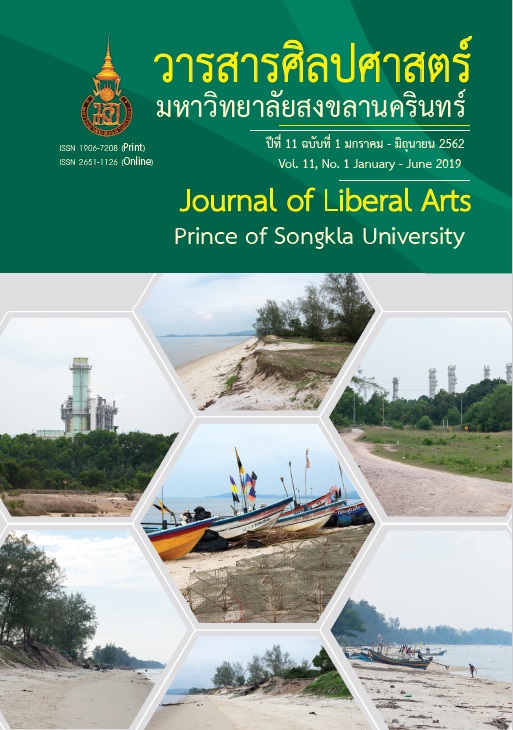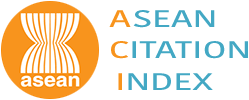Conjunctive cohesion in Thai Islamic verdicts of Sheikhul Islam
Keywords:
Conjunctive cohesion, Islamic verdict, Sheikhul IslamAbstract
This main purpose of this study was to analyze the conjunctive cohesion in Thai Islamic verdicts. The data collected for the study were from 47 Thai Islamic verdicts made by Sheikhul Islam on the official website of the Office of Sheikhul Islam of Thailand. The analysis using percentage revealed that the verdicts comprised 14 categories of conjunctive cohesion ranked from high to low as follows: clarification (26.49%), addition (18.80%), alternation (9.92%), purpose (7.65%), procedure (6.75%), origin (6.14%), time (6.00%), result (3.79%), cause (3.14%), condition (3.10%), contrast (2.54%), exemplification (2.37%), corroboration (1.72%), and transition (1.59%).
References
Alyousef, H. S. and Alnasser, S. M. (2015). A Study of cohesion in international postgraduate business students’ multimodal written texts: An SF-MDA of a key topic in finance. The Buckingham Journal of Language and Linguistics, 8, 56-78.
Baleviciene, D. I. (2014). Density and distribution of cohesion devices in the texts of literary and legal genres (Unpublished master’s Paper), Lithuanian University of Educational Sciences, Department of English Philology.
Benmad, G., Salaming, M. and Baka, D. (2012). Mufti of Thailand: It’s necessity, possibility and model. Al-Nur Journal of the Graduate School of Fatoni University, 7, 43-53. [in Thai]
Black, A. and Hosen, N. (2009). Fatwas: Their role in contemporary secular Australia. Griffith Law Review, 18, 405-427.
Furber, M. (2013). Elements of a Fatwa & their contribution to confidence in its validity. Tabah Analytic Brief, 14, 1-7.
Halliday, M. A. K. & Hasan, R. (1976). Cohesion in English. New York: Longman.
Kaptein, N. and Laffan, M. (2005). Fatwas in Indonesia. Islamic Law and Society, 12, 1-8.
Karanja, M. W. (2014). Discourse analysis of Catholic homilies: A case study of Queen of Apostles Seminary Church, Ruaraka Nairobi (Master’s Dissertation), University of Nairobi, Department of Linguistics and Languages.
Ketabi, S. (2012). A corpus-based study of conjunction devices in English international law texts and its Farsi translation. International Journal of Linguistics, 4, 362-371.
Leedy, P. D. and Ormrod, J. E. (2015). Practical research: Planning and design. Boston, MA: Pearson.
Li, T. C. (2014). A study of conjunctive adverbials in academic journal articles. Journal of Humanity and Sociology, 23, 145-161.
Man, S. (2014). Patterns of Contemporary Ijtihad in Malaysia: Analysis on Fatwas of Malaysian National Fatwa Council. Proceedings from the International Conference on Advances in Management, Economics, and Social Science-MES. Conference 7th to 8th June 2014. Rome, Italy.
Mehmood, M. I. (2015). Fatwa in Islamic law, institutional comparison of Fatwa in Malaysia and Pakistan: The relevance of Malaysian Fatwa model for legal system of Pakistan. Arts Social Sciences Journal, 6, 118.
Panthumetha, N. (2014). Thai grammar. Bangkok: Faculty of Arts, Chulalongkorn University Press. [in Thai]
Panupong, W. and Laolertworakun, A. (2012). Word Class. In W. Panupong and et al, Thai language norms Book 3: Word class, phrase, sentence, and discourse (pp. 16-65). Bangkok: Office of the Basic Education Commission, Ministry of Education. [in Thai]
Prasitratthasin, A. (2012). Discourse. In W. Panupong and et al, Thai language norms Book 3: Word class, phrase, sentence, and discourse (pp. 117-144). Bangkok: Office of the Basic Education Commission, Ministry of Education. [in Thai]
Saleh, M. I. (2011). Dictionary of Islamic words & expressions. Riyadh: Maktaba Dar-us-Salam.
Sheikhul Islam Office. (2017. March). Thai Islamic verdicts of Sheikhul Islam. Retrieved from http://www.skthai.org. [in Thai]
Schiffrin, D. (2006). Discourse. In R. Fasold and J. Connor-Linton (Eds.). An introduction to language and linguistics (pp. 169-199). Cambridge: Cambridge University Press.
Downloads
Published
How to Cite
Issue
Section
License
The authors retain the copyright to their article but the Journal of Liberal Arts, Prince of Songkla University reserves the exclusive rights to first publication.






